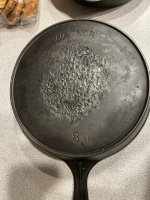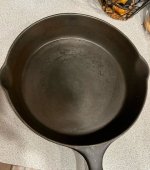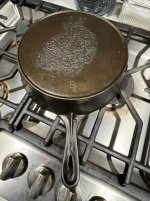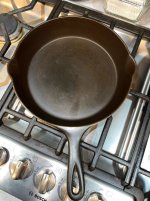So was at my in laws house at Christmas and noticed they had 4 old cast iron pans. They were caked with old seasoning, some probably were not cleaned for 30-40 years it looked! I took them and put them in my electrolysis tank and one by one got them cleaned and seasoned. Well this pitted mess was the most stubborn on the bottom only. The inside of the pan is clean and damage free, the bottom not so much. I finally had to resort to a tap hammer and punch to lightly crack off the 50 year old carbon out of the pits. When that didn't get all of it off I used an exact o knife to crack out and remove the last bits.
The pan is a family heirloom and of no real value because of the damage. I thought about sanding the bottom a little smoother, but I am afraid that the metal is too thin in the pits. I am thinking just leave it alone and use the pan. Am I right in this or is there anything else I can do to help it?

The pan is a family heirloom and of no real value because of the damage. I thought about sanding the bottom a little smoother, but I am afraid that the metal is too thin in the pits. I am thinking just leave it alone and use the pan. Am I right in this or is there anything else I can do to help it?




